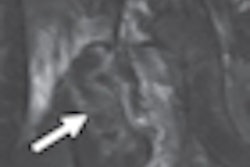Asymptomatic individuals with positive cardiac stress results should proceed to coronary CT angiography (CTA) rather than an invasive cardiac catheterization, according to a new report in the May American Journal of Roentgenology. The study found that low-risk patients received more cost-effective care by using coronary CTA as a gatekeeper test.
"Although routine screening for asymptomatic coronary artery disease (CAD) is not endorsed by clinical practice guidelines, patients with asymptomatic cardiac risk factors often undergo stress testing, especially before surgery or before starting a vigorous exercise program," wrote lead author Dr. Ethan Halpern and colleagues from Thomas Jefferson University in Philadelphia (AJR, May 2010, Vol. 194:1, pp. 1257-1262). "Furthermore, a substantial number of exercise stress tests in general medical practice are performed on patients at low to intermediate risk for indications such as atypical chest pain, multiple cardiac risk factors, and screening."
This means that many asymptomatic patients wind up with positive results on the stress test, an exam that is limited by its high false-positive rate and by positive predictive values as low as 13.5%. In the authors' experience, most of these patients have no significant coronary artery disease, hence the need for a noninvasive alternative.
"The purpose of this study was to use decision-tree analysis to determine the cost-effectiveness and radiation dose that would result from performing coronary ... CTA before catheterization," they wrote.
Model comparison
The model compared false-positive and false-negative rates, costs, and radiation exposure associated with two scenarios: performing invasive cardiac catheterization versus coronary CTA for asymptomatic patients with a positive stress test. The authors assumed that only those patients with a positive coronary CTA result would be referred for cardiac catheterization.
The model referred to the 2009 Medicare Physician Fee Schedule for costs associated with both catheterization and coronary CTA, and relied on a literature review of recent meta-analyses and multicenter trials for data on sensitivity, specificity, and radiation doses of the two exams.
"Because of continual improvements in technology, the effective radiation dose for both coronary CTA and diagnostic cardiac catheterization is difficult to specify," Halpern and colleagues noted. "In the interest of using the effective dose with the latest technology, on the basis of clinical reports we assumed a 4.2-mSv effective dose for prospectively gated coronary CTA. The effective dose for diagnostic cardiac catheterization was set to 7 mSv for baseline computations but was varied down to 5 mSv for sensitivity analysis."
The analysis looked at expected rates (proportions) of true and false diagnoses among the population referred for testing as follows:
- True-positive rate (TPR) = prevalence multiplied by sensitivity
- False-negative rate (FNR) = prevalence minus true-positive rate
- True-negative rate (TNR) = (1 minus prevalence) multiplied by specificity
- False-positive rate (FPR) = (1 minus prevalence) minus true-negative rate
The group found that when patients had an expected CAD prevalence of less than 85% combined with a positive stress test result, coronary CTA was a less expensive and lower radiation-dose alternative to direct performance of cardiac catheterization.
The expected values for false-negative rates, false-positive rates, cost, and effective radiation exposure varied depending on the prevalence of significant CAD in the study population, the group noted.
"FNR increases with the prevalence of CAD from 0.05% at a disease prevalence of 0.01 to 4.5% at a prevalence of 0.9," the authors wrote.
When the prevalence of CAD was less than 0.4, the false-negative rate remained less than 2%. The false-positive rate decreased with the prevalence of CAD, from 17% at a disease prevalence of 0.01 to 1.7% at a prevalence of 0.9. At a CAD prevalence of 50%, the false-negative rate was estimated to be 2.5% with a false-positive rate of 8.5%.
Based on the model assumptions at baseline, performing coronary CTA before triaging patients to cardiac catheterization "reduces overall diagnostic costs as long as the prevalence of disease is less than 85%," the authors wrote.
Reserving catheterization for stress-positive patients with a disease prevalence greater than 85% reduced average diagnostic costs by $789 at a CAD prevalence level of 50% and by more than $1,000 at a CAD prevalence less than 40%, the team reported. Even when the study team assumed lower specificity numbers than found in the literature, initial use of coronary CTA reduced overall diagnostic costs as long as disease prevalence remained less than 75%.
Less radiation, too
Radiation dose was also lower in the CTA-first model, although less dramatically than in the cost comparison.
Assuming a mean effective dose of 7 mSv for diagnostic cardiac catheterization, effective radiation exposure was lower using electrocardiogram-gated CTA. When the CAD prevalence increased to 50%, effective radiation exposure increased from 7 mSv to 8.1 mSv, the group reported.
"Sensitivity analysis showed that at a disease prevalence up to 40%, the effective dose can be reduced by initial performance of coronary CTA provided the specificity is kept to 90%," Halpern and colleagues wrote. "Even when specificity decreases to a value as low as 64%, starting with coronary CTA increases the effective radiation dose only ... from 7 to 8.5 mSv at a disease prevalence of 40%."
On the other hand, when using retrospectively gated coronary CTA, the mean effective dose increased -- by 4.25 mSv when disease prevalence is very low and up to 9 mSv at a disease prevalence of 90%, according to the model.
"According to our results, when a patient with an expected CAD prevalence less than 85% is found to have a positive stress test result, coronary CTA is a less expensive alternative to direct performance of cardiac catheterization," Halpern and colleagues wrote.
The cost savings were inversely related to the probability that the patient with the positive stress test result has coronary artery disease, they noted. As a result, coronary CTA findings in low-risk patients are more likely to obviate the need for cardiac catheterization.
The appropriateness criteria for coronary CTA generally call for use of coronary CTA in evaluating patients who have symptoms; however, the appropriateness criteria do not directly address the scenario of an asymptomatic patient with a positive stress test result.
"Experience in our cardiac catheterization laboratory suggests that asymptomatic positive stress test results are not uncommon," they wrote. "In addition, our decision analysis can be generalized to any patient with a positive stress test result who has atypical chest pain or symptoms that probably are not related to CAD. Our results suggest that coronary CTA would be a highly appropriate study in the care of such patients."
At a coronary artery disease prevalence of 50%, the group calculated an expected false-negative rate of 2.5%, meaning that clinicians can expect a slight increase in the rate of missed diagnoses if they proceed first to coronary CTA.
Nevertheless, "if a clinician is willing to screen a patient using a stress test that has a sensitivity of no more than 80% to 90%, we should not hesitate to retest the patient using coronary CTA, which has an expected sensitivity of 95% to 100% and an FNR of 2.5%," they wrote.
By Eric Barnes
AuntMinnie.com staff writer
April 23, 2010
Related Reading
Coronary CTA finds plenty of plaque in runners, March 17, 2010
Women sent to cath lab twice as often as men, March 15, 2010
Zero calcium score enough to send chest pain patients home, February 10, 2010
Analysis favors coronary CTA over stress MPS for chest pain, January 15, 2010
Angina predicts severe angiographic coronary disease in women, January 15, 2010
Copyright © 2010 AuntMinnie.com



















